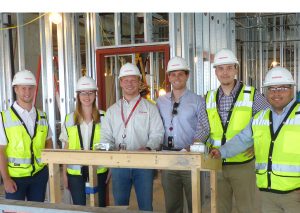Charles Bradshaw, Virtual Construction and Technology Manager at Doster Construction Company, has seen businesses of all sizes benefit from Building Information Modeling [BIM] and Construction Technology. Effective data management is vital to the success of construction projects across industries, and BIM is steadily gaining traction in the south as companies take note of its positive impacts on workflows in the office and in the field.
Bradshaw likes to describe BIM as ‘Better Information Management;’ a description that perfectly captures the purpose of the technology. From preliminary designs to 3-D building modeling, prefabrication to business analysis, technology is now available to the construction industry and it is paving the way for more streamlined project implementation, with safer, higher quality results.
In fact, Bradshaw sees a time in the not-too-distant future when companies who do not offer services such as BIM will miss out on job opportunities.
“Right now, we’re in the in between: people are still trying to figure this out,” says Bradshaw. “But there’s coming a point in time where these services will be mandated. Customers are going to know who does or doesn’t do this, and the companies that don’t will not be brought to the table.”
The good news is that embracing these technological innovations can only help companies in the long run–and contrary to what many people think, BIM is attainable with budgets of most any size. It’s all a matter of identifying the right solutions for the job at hand.
“Starting out, BIM and Construction Technology can be intimidating,” Bradshaw notes, “leaving some owners and contractors thinking, ‘How could we ever do that? The key here is that you can use small bits and pieces of technology to give you initial wins to get the ball rolling. These pieces aren’t overly expensive and can yield big benefits.”
THE FIRST STEP: COORDINATION
The lowest hanging fruit in BIM and construction technology is coordination through a shared platform where a project can be taken from early design to as-builts, Bradshaw explains. This method delivers optimal planning results, and lowers the risk of mistakes due to miscommunication.
Traditional estimating protocol involves sharing data from department to department, traditionally with spreadsheets, which can lead to breaks in the data flow. Now, companies can pull data from different systems and establish a thread from precon to the field and back to precon again, all in one fluid cycle. Each piece of data can be viewed by every team member simultaneously, and can be accurately trended to pinpoint strategic growth and learning opportunities.
“Companies can now look at data in all its facets, and see how many jobs they’re pursuing to get a job,” Bradshaw explains, “and ask questions like, ‘if we want to grow next year, how many leads do we need to generate?’ They can make better judgment calls on future projects based on information available on past projects, including cost, production, safety, and trending change orders.”
BIM IS NOT ONE-SIZE-FITS-ALL
Bradshaw is passionate about helping companies implement the technology that will yield positive, tangible results. To this end, he has three questions to help guide them as they consider their options:
- What can we use to make our processes better?
- What helps take the burden off of us?
- What helps mitigate risk?
One of the biggest pitfalls that Bradshaw sees companies encounter is investing in technology that at best will not improve their process and at worst could actually impede progress. For example, just because a company buys a good quality laser scanner – which costs anywhere from $50,000 to $150,000 – does not automatically mean it will give them any benefit. If it’s useful for the types of projects the company does, then it is a good investment. If it isn’t, it’s just money out the door.
“With any new tech or process, it’s very easy to think, ‘this is new and cool,’ Bradshaw explains, “but that doesn’t mean it’s going to bring value.” Instead, companies should ask themselves if a product truly has the potential to positively impact their success down the road.
“Everybody’s workflow is just a little bit different,” Bradshaw adds. “You have to look at the product and touch it and really make a careful decision based on your own circumstances.”
PEOPLE MATTER
Even if one particular BIM product sounds like a good idea, Bradshaw notes that companies still need to take sociology into account as they weigh their options.
“Companies should be able to look at their culture and say, ‘this won’t be a fit here because we’re not ready. But this other piece will succeed here, because we have problems with this, and people are ready to solve that problem,’” Bradshaw says.
The next step is to effectively integrate the solutions they choose into their workflow.
For some companies, that integration comes in the form of technological training. For others, a symbiotic relationship between a younger person with tech experience and an older person with job experience works best. “This piece of the puzzle is usually harder for companies to figure out,” Bradshaw says, and it may vary depending on what BIM solutions are chosen.
PASSION MATTERS MOST
No matter what product ends up being the best fit, the most important factor for its success is the team in charge of managing it. Specifically, whoever spearheads the effort must genuinely care about the work they’re doing.
“You can’t just assign it to someone and say, ‘you’re going to do this.’ I’ve never seen that work great,” Bradshaw says. “But if companies find team members who are passionate about the new technology, they will bring energy and profitability to the project.”
“If you give them the challenge of, ‘here’s the risk we’re trying to mitigate,’ then allow them to go study and identify solutions, you will be very happy with what they bring back to you,” Bradshaw adds.
The team doesn’t have to just be young people or IT specialists, either. Bradshaw has worked on teams with 30+ year construction veterans who openly admit they don’t feel very tech-savvy –and yet, they can be the best fit for the job. If they’re tuned in to the pros and cons and can keep an open mind while also being critical, they have the most experience to leverage.
When an enthusiastic team gets together, they can stay inquisitive, bounce ideas off of each other, and work together to improve the process. The results will speak for themselves.
MOVING FORWARD
BIM continues to evolve year after year, and the biggest impact can be observed on the field, Bradshaw says. Having the ability to look at a project in 3-D and know where all of the components hit each other before a single shovel hits the ground is invaluable. This information means less (or possibly no) field modifications, and companies can prefabricate strategic items and have them fit precisely when they’re brought to site.
“The industry is also suffering from a lack of skilled labor,” Bradshaw adds. “Contractors who in the past could make decisions, know where things should be and coordinate in the field are retiring. So, having components that are worked out ahead of time makes the process faster, safer, and ensure that high quality of projects is still there.”
FUTURE TECH IS HERE
“The amount of change and technology out there –what’s coming out, what we can do now—is incredible.” – Charles Bradshaw, Virtual Construction and Technology Manager at Doster Construction Company
Two innovations worth exploring:
360-DEGREE PHOTOS
This economical software allows anyone to walk around the site and record the complete scope of the job, without taking up valuable contractor or superintendent time. Each room can be viewed in a single photo, helping the team identify pain points, fixes, and keep track of progress. This also gets rid of the hassle of extracting images from cell phones and weeding through hundreds of unnecessary photos.
AUTODESK ASSEMBLE SYSTEMS
Software such as this is becoming more affordable overtime, especially within the realm of BIM software. It allows team members to get into a model, touch it, spin it around, look at the geometry, and fully explore without any fear of deleting or removing the information. Software can be an easy win situation, because it allows for detailed, hands-on analysis of a project without the learning curve from a complex system.
This article was first published in BuildSouth’s Fall 2019 Magazine.



